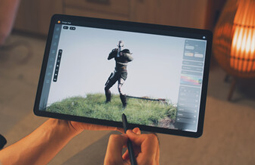Exploring Solid 3D Modeling - A Comprehensive Guide 2024
The benefits 3D technology has for modern engineering go beyond just the design process. The information contained within a 3D model helps architects and engineers develop detailed 3D models of physical objects, as well as experiment with different variations. One such approach is solid 3D modeling, which represents 3D objects as volumes. This 3D modeling method has quickly become the cornerstone of engineering CAD models owing to its geometrical accuracy.
Today, in this comprehensive article, let’s explore this significant modeling technique, why it is so essential for manufacturing and engineering, what its applications are, and future predictions. Understand everything about parametric modeling and transform your creative ideas into detailed, accurate digital models. Let’s begin!

What is solid 3D modeling, and why is it so essential to 3D design?
It is a 3D CAD modeling technique to create geometrically accurate and realistic 3D representations of existing 2D designs. The physical 2D objects can be anything, ranging from engineering structures, architectural constructions, machinery parts, furniture products, and more. The transformation from 2D to 3D happens through specialized modeling software programs.
This digital modeling procedure has a wide application across diverse industries and is one of the most complex CAD skills.
The fundamental importance of solid models lies in their precision and high level of geometric accuracy. Owing to these facets, product designers and engineers can generate exact digital representations, making this technique integral to manufacturing and engineering. The representation encompasses the internal and external geometry of the product or component.
This is pivotal for industrial fields where even the smallest of design errors can pose severe repercussions like automotive, AEC, mechanical engineering, medical imaging, and aerospace.
The best part of parametric models is their seamless integration with high-end engineering analysis software. The models can be easily imported into the tools and simulated with physical behaviors, such as thermal dynamics, strain, aerodynamics, pressure, stress, etc. This product assessment process is integral to quality control and identifying potential errors.
Also, solid digital models are adequately compatible with different manufacturing techniques, such as injection molding, CNC machining, 3D printing, etc. The generated parametric models can be directly utilized to streamline the manufacturing process and create mold designs, product designs, and the like. Before approving the designs for the final production, their viability can be thoroughly checked.
Different types of solid 3D models
Different types of solid 3D models are there, each having distinct traits and applications. Since solid models are whole, unlike wireframe or surface models, they give realistic representations of internal cavities and structures. A few solid model types are as follows:
Parametric models: Parametric 3D models are based on mathematical parameters defining shapes between different points of the model. These mathematical constraints also help understand relationships of the parts of the physical object. The beauty of these models is they can be easily modified by simply updating the parameters.
Feature-based solid models: These types of solid models are comprised of predefined features like patterns, fillets, holes, and chamfers. These predefined features can be manipulated or combined to create complex shapes. Feature-based models are mainly used in CAD applications and mechanical engineering designs.
Direct solid models: Direct solid models are best for conceptual designs and fast modifications. Hence, they are used mainly for intuitive rapid prototyping projects. Direct 3D solid models’ geometry is without any parametric constraints and can be manipulated directly.
Mesh 3D models: Mesh models have polygons, or a set of edges, vertices, coordinates, and faces. These polygonal models are ideal for animation and graphics software programs for creating organic shapes, terrain, characters, etc.
Depending on specific project requirements, each of the above types of solid models is applied. Advanced software programs are required for generating these models; only professional 3D services providers can execute these software tools.
What are the advantages and disadvantages of 3D solid modeling?
Despite being a crucial aspect of the 3D design process, solid modeling has its limitations. As much as the pros or advantages expand the technique’s possibilities, the cons put some limitations on it. Let’s quickly take a look at some of the pros and cons of solid 3D modeling.
Advantages:
Enhances design representation: Solid models are virtual, 3D previews of the final product. This makes it easier to visualize and interpret the design.
Improves design accuracy: 3D modelers can identify and fix design errors early in the development stage. This ensures precise and accurate designs.
Simplifies product modifications: The 3D solid modeling module makes design alteration simple and quick if required in the product development stage. The best part is nothing is required to be done from scratch.
Facilitates rapid prototyping: Solid modelers can turn a design into a physical, real-life prototype for testing faster than any other modeling technique.
Supports automated design analysis: Engineering designers can analyze the models created by the solid modeling method. Using software automation, they can check and validate the design versions to determine whether they meet all requirements and defined criteria.
Disadvantages:
Needs higher processing power: Solid modeling procedure requires higher processing power than other methods. This makes the process unsuitable for computers with low specifications.
Steep learning curve: Solid 3D modeling is difficult for beginners to grasp, considering its complex nature and intense learning process.
Time-consuming: The technique demands substantial time given the complexity and precision solid models have.
Expensive and high-end software programs: The software requirements are high-end and much more expensive than other modeling techniques. This makes it less suitable for individuals, start-ups, or SMEs/SMBs.
Limited creative freedom: Modelers and designers can have less creative and artistic freedom as solid models are more focused on geometric precision than artistic flexibility.
Applications of solid 3D models across diverse industries
Mechanical engineering
Mostly in the aeronautical and automotive engineering sectors, prototypes are a must. 3D solid models act as the perfect tool for rapid prototyping for testing purposes. Also, for the assessment and assembly of highly complex engineering machinery parts, these models are leveraged.
Construction & architecture
In the AEC domain, solid models are widely used by architects and civil engineers. To visualize the proposed plan of civil constructions and buildings, solid model designing is vital given its ultra level of geometric accuracy and precision.
Healthcare and medical sector
Solid models are extensively used for generating prosthetics, dentures, surgical instruments, implants, and more. Since solid modeling is focused solely on accurate geometrical parameters, exact life-like anatomy models can be created for medical assessments. Medical procedures can also be simulated and tested without involving any actual humans.
Consumer product manufacturing
The solid modeling technique is also used to create product 3D models of consumer goods and electronic appliances. These can vary from furniture, wearables, apparel, and electronic appliances, to other eCommerce products, like cosmetics, eyegear, and the like.
Interior design
Solid models greatly help interior designers and planners get a full view of the room, sometimes even before the construction is actually completed. Floor planners also get much help from solid room models to get an idea of the inside space. Interior designers and furnishers can change the material, patterns, textures, and colors as many times as they want on the solid 3D model replicas of the rooms. Professional interior designers hire specialists offering 3D modeling services for floor plans and interior design models.
Entertainment and animation
Solid modeling is best used for creating CGI in animated movies, video game characters and environments, backgrounds, character animations, etc. Special visual effects are also created using this highly precise 3D design and visualization technique.
Future trends and predictions in solid modeling
We have arrived at the final segment of this interesting article. Combining innovation with technique is the newest approach, offering a hybrid of design and visualization. Let’s explore the emerging technologies and future trends that will practically shape the future of the solid three-dimensional modeling process.
-
Generative design and topology optimization
Solid models will be used more and more for generative design driven by AI. These intuitive, personalized designs will further help in topology optimization or understanding the relationship between two points of an object.
-
Integration with additive manufacturing
The usage of 3D parametric models is no longer limited to just engineering design and industrial product modeling. The technology can also be seamlessly integrated with 3D printing for a sustainable additive manufacturing process.
-
Cloud-based CAD/CAM solutions and collaboration tools
Parametric 3D mesh models can be operated within collaborated teams through cloud-based project collaboration tools mainly for optimization and iteration purposes. Not just this, but with further R&D, we shall also get online CAD/CAM solutions based on real-time cloud computing technology.
-
Artificial intelligence and machine le
The future will see more and more AI-powered design automation applications wherein solid mesh models will play a significant role. Especially for machine learning purposes, more accurate generative 3D models can be created by integrating solid modeling techniques with AI tools.
Wrapping up
So you see, solid 3D modeling is a vast concept with several applications, implementations, types, and possibilities. If you have always wondered what is 3D solid modeling, hope you have got your answer. Understanding this parametric modeling technique is crucial for all 3D professionals, whether beginner, intermediate, or pro. Professional agencies offering advanced 3D design services have experts fluent in such advanced 3D design methods.
As technology evolves, more dynamic advancements can be expected in the fields of 3D technology. For artistic visualization and mathematical accuracy, we can see other CAD techniques that effectively analyze components, machines, thermodynamics, and structures. Hire 3D specialists who are thoroughly acquainted with these updates. Good luck!




